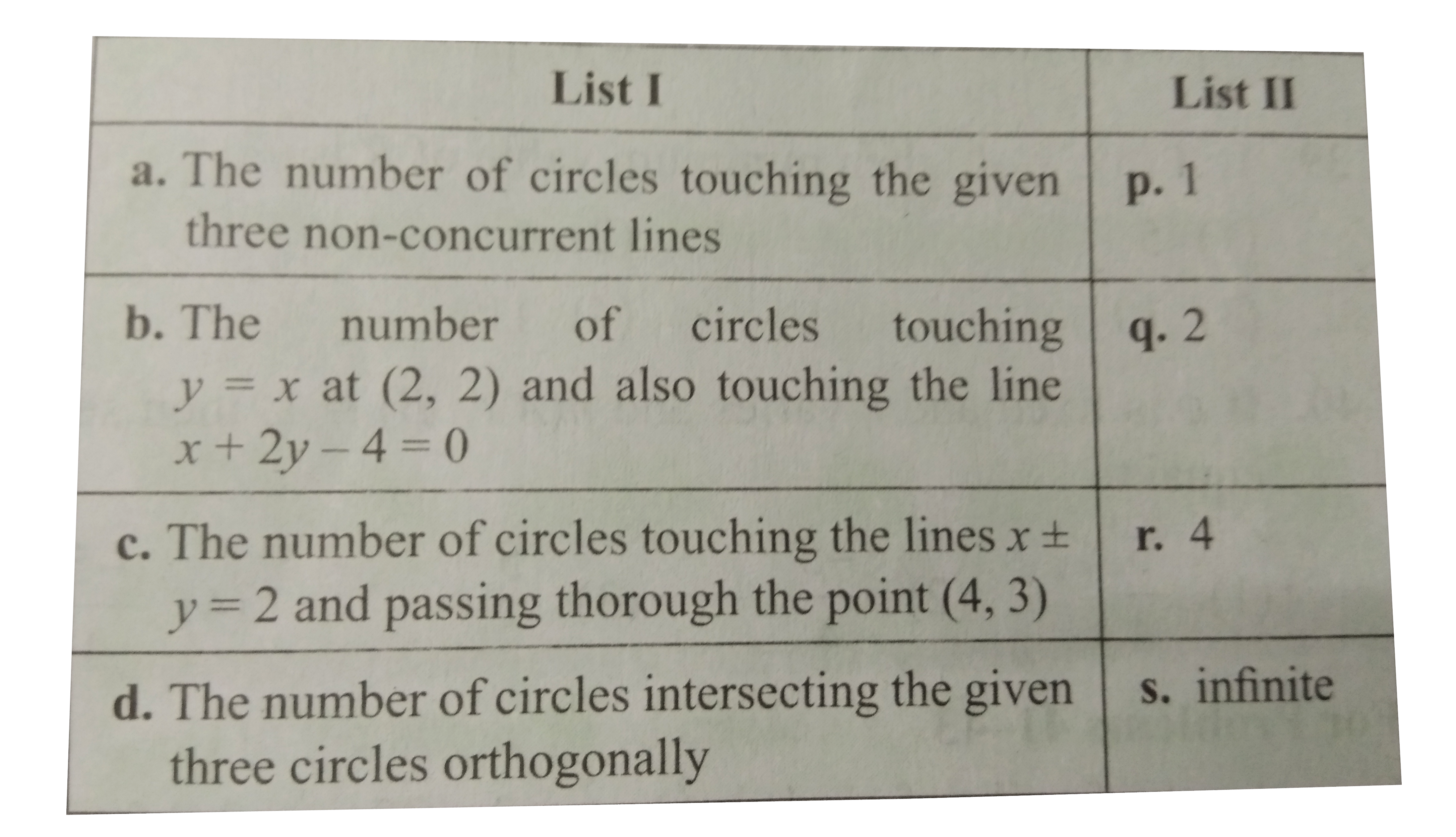The sixth term in the expansion of (√2log(10−3x)+(2(x−2)log3)15)m is equal to 21, if it is known that the binomial coefficient of the 2nd 3rd and 4th terms in the expansion represent, respectively, the first, third and fifth terms of an A.P. (the symbol log stands for logarithm to the base 10) The value of m is
1
3
4
2
The correct Answer is:D
To solve the problem, we need to find the value of m in the expression
(√2log(10−3x)+(2(x−2)log3)1/5)m
given that the sixth term in its expansion equals 21, and the binomial coefficients of the 2nd, 3rd, and 4th terms represent the first, third, and fifth terms of an arithmetic progression (A.P.).
Step 1: Simplify the expression
First, we simplify the terms inside the binomial expansion:
1. First term:
√2log(10−3x)=212log(10−3x)=(10−3x)12
2. Second term:
(2(x−2)log3)1/5=2(x−2)log35=3x−25
Thus, we can rewrite the expression as:
((10−3x)12+3x−25)m
Step 2: Identify the sixth term
Using the binomial theorem, the k-th term in the expansion of (a+b)m is given by:
Tk=(mk−1)am−k+1bk−1
For the sixth term T6:
T6=(m5)((10−3x)12)m−5(3x−25)5
This simplifies to:
T6=(m5)(10−3x)m−52⋅3x−21=(m5)(10−3x)m−52⋅3x−2
Step 3: Set up the equation
We know that T6=21:
(m5)(10−3x)m−52⋅3x−2=21
Step 4: Analyze the A.P. condition
The binomial coefficients of the 2nd, 3rd, and 4th terms are:
- (m1)
- (m2)
- (m3)
For these to be in A.P., we need:
2(m2)=(m1)+(m3)
Using the binomial coefficient identities:
- (m1)=m
- (m2)=m(m−1)2
- (m3)=m(m−1)(m−2)6
Substituting these into the A.P. condition gives:
2⋅m(m−1)2=m+m(m−1)(m−2)6
Simplifying this leads to:
m(m−1)=m+m(m−1)(m−2)6
Step 5: Solve for m
Multiplying through by 6 to eliminate the fraction:
6m(m−1)=6m+m(m−1)(m−2)
Rearranging and simplifying leads to a polynomial equation in m. Solving this polynomial will yield the possible values for m.
Conclusion
After solving the polynomial, we find the value of m that satisfies both the condition of the sixth term being 21 and the A.P. condition.
√2log(10−3x)=212log(10−3x)=(10−3x)12
(2(x−2)log3)1/5=2(x−2)log35=3x−25
((10−3x)12+3x−25)m
Tk=(mk−1)am−k+1bk−1
T6=(m5)((10−3x)12)m−5(3x−25)5
T6=(m5)(10−3x)m−52⋅3x−21=(m5)(10−3x)m−52⋅3x−2
(m5)(10−3x)m−52⋅3x−2=21
- (m1)
- (m2)
- (m3)
2(m2)=(m1)+(m3)
- (m1)=m
- (m2)=m(m−1)2
- (m3)=m(m−1)(m−2)6
2⋅m(m−1)2=m+m(m−1)(m−2)6
Simplifying this leads to:
m(m−1)=m+m(m−1)(m−2)6
6m(m−1)=6m+m(m−1)(m−2)
Topper's Solved these Questions
- BINOMIAL THEOREMBOOK - CENGAGE ENGLISHCHAPTER - BINOMIAL THEOREMEXERCISE - Numerical
25 Videos
- BINOMIAL THEOREMBOOK - CENGAGE ENGLISHCHAPTER - BINOMIAL THEOREMEXERCISE - Archives
16 Videos
- BINOMIAL THEOREMBOOK - CENGAGE ENGLISHCHAPTER - BINOMIAL THEOREMEXERCISE - Multiple Correct Answer Type
27 Videos
- AREABOOK - CENGAGE ENGLISHCHAPTER - AREAEXERCISE - Comprehension Type
2 Videos
- CIRCLE BOOK - CENGAGE ENGLISHCHAPTER - CIRCLE EXERCISE - MATRIX MATCH TYPE
7 Videos
Similar Questions
Match the given lists.

View SolutionThe remainder left out when 82n(62)2n+1 is divided by 9 is (1) 0 (2) 2 (3) 7 (4) 8
View SolutionThe value of x in the expression (x+x(log)10x)5 if third term in the expansion is 10,00,000 is/are
a. 10 b. 100 c. 10−5/2 d. 10−3/2
View SolutionIn the following figure, the graphs of two functions y = f(x) and y = sin x are givne. They intersect at origin, A(a,f(a)),B(π,0)andC(2π,0).Ai(i=1,2,3) is the area bounded by the curves as shown in the figure, respectively, for x∈(0,a),x∈(a,π),x∈(π,2π).
If A1=1+(a−1)cosa−sin a, then

The function f(x) is
View SolutionMatch the following lists.

View SolutionThe sixth term in the expansion of (√2log(10−3x)+(2(x−2)log3)15)m is equal to 21, if it is known that the binomial coefficient of the 2nd 3rd and 4th terms in the expansion represent, respectively, the first, third and fifth terms of an A.P. (the symbol log stands for logarithm to the base 10) The value of m is
View SolutionIf the coefficients of 2nd , 3rd and 4th terms of the expansion of (1+x)2n are in A.P. then the value of 2n2−9n+7 is
View SolutionIf the coefficients of 2nd , 3rd and 4th terms of the expansion of (1+x)2n are in A.P. then the value of 2n2−9n+7 is
View Solutionयदि द्विपद [√2log(10−3x)+5√2(x−2)log3]m के प्रसार में 6 वां पद 21 के बराबर हैं तथा यह ज्ञात हैं कि प्रसार में दूसरे, तीसरे तथा चौथे पदों के द्विपद गुणांक क्रमश: समान्तर श्रेणी के प्रथम, तृतीय तथा पंचम पद हैं (संकेत log आधार 10 के सापेक्ष लघुगणक के लिये प्रयुक्त हैं ) तब x=
View SolutionThe sixth term in the expansion of (√2log(10−3x)+(2(x−2)log3)15)m is equal to 21, if it is known that the binomial coefficient of the 2nd 3rd and 4th terms in the expansion represent, respectively, the first, third and fifth terms of an A.P. (the symbol log stands for logarithm to the base 10) The value of m is
View SolutionThe sixth term in the expansion of (√2log(10−3x)+(2(x−2)log3)15)m is equal to 21, if it is known that the binomial coefficient of the 2nd 3rd and 4th terms in the expansion represent, respectively, the first, third and fifth terms of an A.P. (the symbol log stands for logarithm to the base 10) The value of m is
View Solutionm, n∈N के लिये, माना द्विपद (√2log(10−3n)+5√2(n−2)log3)m के प्रसार में 6 वाँ पद 21 है। यदि 2nd, 3rd एवं 4th पद के द्विपद गुणांक क्रमशः एक समान्तर श्रेणी के 1st, 3rd एवं 5th पद को दर्शाते है। (m+n) ज्ञात करें। (log का आधार 10 है।)
View SolutionIf the coefficients of 2nd, 3rd and 4th terms in the expansion of (1+x)2n are in A.p., then prove that 2n2−9n+7=0.
View SolutionIf the coefficients of 2nd, 3rd and 4th terms in the expansion of (1+x)2n are in A.P. then
View SolutionThe sixth term in the expansion of ( sqrt(2^(log(10-3^x))) + (2^((x-2)log3))^(1/5))^m is equal to 21, if it is known that the binomial coefficient of the 2nd 3rd and 4th terms in the expansion represent, respectively, the first, third and fifth terms of an A.P. (the symbol log stands for logarithm to the base 10) The value of m is
View Solution

